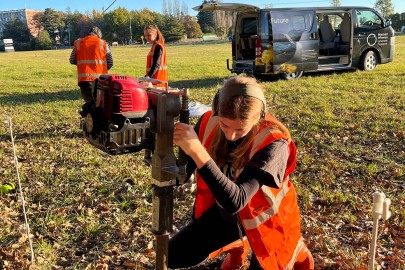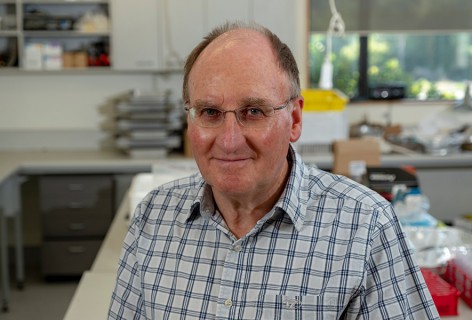
Katie O’Hagan, an honours student at the University of Canterbury, taking a soil core at the Manaaki Whenua site in Lincoln
The research programme, Integrating trees to target zero carbon and add value to rural landscapes, led by principal researcher Dr David Whitehead and researcher Dr Sam McNally, aims to quantify the enhanced biomass and soil carbon stocks associated with edge effects from small clusters of trees, and additional co-benefits, compared with continuous plantation forestry.
Field measurements at sites across the country will be combined with innovative metagenomic approaches, isolating and analysing DNA from environmental samples, to provide new insights into the role of specific microbial processes that regulate ecosystem carbon cycling at the edges of tree clusters. The research will seek to prove the benefits to biomass and soil carbon stocks from planting low-density mosaics of trees within grasslands.
Combining the field measurements with modelling will show how the optimal spatial arrangement of trees in grasslands matched with soil and climatic conditions can increase carbon stocks and lead to additional co-benefits including increasing diversity of products (e.g. nuts, honey), provision of alternative animal fodder, providing shelter for animals, improving water quality and enabling of kaitiakitanga in rural landscapes. Our researchers will be working with national partners from AgResearch, Scion, NIWA, Lincoln University, University of Canterbury, Māori organisations including an ahuwhenua Māori Trust at Te Whaiti, existing Māori special interest groups (e.g. the Kānuka Entity, Ngā Pou a Tāne / National Māori Forestry Association) and Māori agents of change in the agribusiness sector, plus international collaborators from France, the Netherlands, the USA and Australia.
First steps for the research are to co-develop the research plan with end users and identify the criteria that will be used for selection of 32 sites for field measurements across the country.
Implementation of the programme’s recommendations will be wide-ranging and inclusive, to ensure relevance for landowners and policy makers. The work will assess the economic and cultural values of improved carbon stocks, and will identify constraints on landowner decision-making. Research results will be co-developed and shared with landowners, Māori organisations, regional councils and relevant government departments.
Compared with plantation forestry, over 30 years, the researchers initially estimate that establishing mosaics of tree clusters on low-productivity grasslands on 25% of the land area currently recommended for forestry could result in additional biomass and soil carbon stocks equivalent to offsetting 1.5 years of Aotearoa New Zealand’s current gross greenhouse gas emissions, or 3 years of the country’s agricultural emissions – a very significant contribution to emissions reduction.
“This is an exciting opportunity for research to recommend new approaches to landscape design for Aotearoa New Zealand to reduce net greenhouse gas emissions, while enabling kaitiakitanga and enhancing well-being for rural communities”, says David.
Key contact

